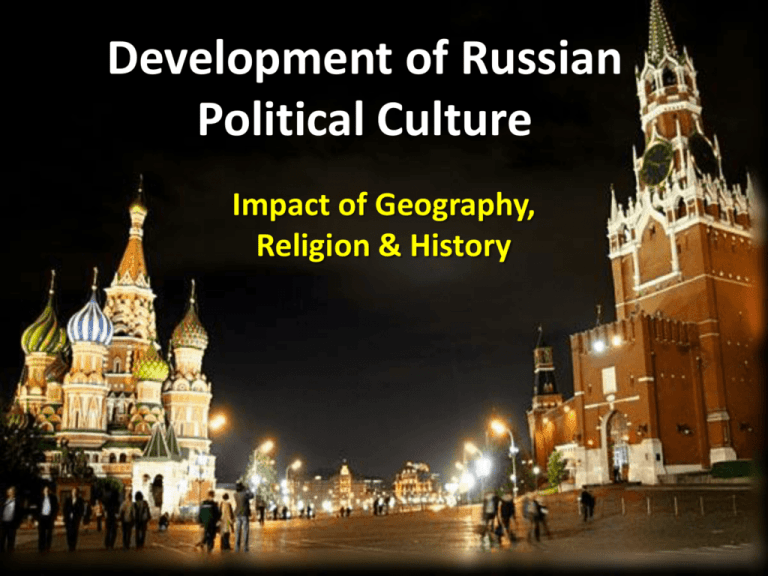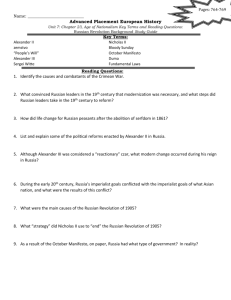Russian Political History and Development
advertisement

Development of Russian Political Culture Impact of Geography, Religion & History Russian Geography • Russia in the largest country in the world – Even after losing several states following the 1991 collapse Baltic Sea Arctic Ocean Europe Pacific Ocean Moscow Black Sea China Middle East Russian Geography • Russia is the largest country in the world – Even after losing several states following the 1991 collapse • Culturally Very Diverse (Cultural Heterogeneity) – 160 ethnic groups – 100 languages (28 officially) – 73% urban; 27% rural – 141,927,297 total population – low density Russian Religion • 988 A.D. Russia adopted the Eastern Orthodox (Christian) Religion – Separated Russia from Western Europe • Lack of shared values (individualism) created by the Renaissance, Reformation, Scientific Revolution, & Enlightenment • Russians valued a strong state, to protect them from their geographic vulnerabilities Russian Political History Tsarist Russia • Since the beginning Russian tsars were autocratic, ruling with absolute power – Supported due to the chaos caused by foreign invaders like the Huns, Vikings, and Mongols invading Russian lands • Tsars also headed the Russian Orthodox Church – Political & Religious Leader • “Slavophile” – lover of Slavs; pride in Slavic/Russian customs & traditions that caused Russia to resist outside influence Slavophile vs. Westernizer • Tsar Peter the Great & Catherine the Great were considered ‘Westernizers’ challenging the desire for isolation – Peter used western models to modernize Russia’s military, infrastructure, and bureaucracy – St. Petersburg example – Catherine added a warm water western port and integrated some Enlightenment ideas into her rule Peterhof Palace (Versailles copy?) 1917 Revolution • Russian war struggles against Japan and during WWI gave rise to civil unrest and a desire for a new direction under a Marxist philosophy. – Explain Marx’s view of history and vision of the future described in the Communist Manifesto 1917 Revolution • Lenin & the Bolsheviks – Explain how Lenin altered Marxism into Russian Communism • Lenin argued for democratic centralism – a vanguard leadership group that would lead the revolution in the name of the people. – Rule by a few for the good of the many (dictatorship of the proletariat) – Group became called the Bolsheviks Joseph Stalin • Joseph Stalin succeeded Lenin and created a totalitarian state under the Communist Party. • Purges – Stalin eliminated any and all dissidents or potential threats to his power – Use of the Gulag Joseph Stalin, General Secretary (1927-1953) General Secretary Head of the Politburo, who assumed full power as dictator of the country Politburo group of about 12 men who made the decisions and ran the government Central Committee a group of 300 part leaders Nomenklatura Process of selecting recruits within the party Communist Party (7% of the total Population) Stalin’s Economy Policy • Stalinism – two-pronged program of collectivization and industrialization 1. Collectivization – private land ownership was eliminated and replaced by state-run collective farms 2. Industrialization – Stalin’s 5 Year Plan set goals to develop Russian heavy industry • Stalinism was based on central planning. – What is central planning? – What are 2 problems w/ central planning? Stalin’s Economy Policy Khrushchev & deStalinization • In 1953 Nikita Khrushchev began a process of deStalinization – a process that led to loosening of government; censorship of press, decentralization of economic decision-making, restructuring of collective farms • Khrushchev also called for a peaceful coexistence with the United States. Russian leader Khrushchev and then Vice President Richard Nixon in Moscow in 1959. Mikhail Gorbachev • In 1985 Mikhail Gorbachev implemented further reforms – to ‘save’ Russia 1) Glasnot – “openness”; it allowed more open discussion of political, social and economic issues as well as open criticism of the government. Mikhail Gorbachev Gen. Secretary 1985-1991 Russian President 1991 Mikhail Gorbachev 2) Democratization – introducing a ‘little democracy’ into the Soviet political system New legislature with directly elected representatives A new President position appointed by the legislature Mikhail Gorbachev Gen. Secretary 1985-1991 Russian President 1991 Mikhail Gorbachev 3) Perestroika – transferred many economic powers held by the central government to private hands and the market economy. Mikhail Gorbachev Gen. Secretary 19851991 Russian President 1991 Revolution of 1991 • In August 1991, ‘conservatives’ attempted a coup d'état to remove Gorbachev. • The coup failed, popular protest led by Boris Yeltsin broke out. • In December 1991, 11 Russian Republics declared their independence and Gorbachev announced the end of the Soviet Union The Russian Federation • Under Boris Yeltsin, the Constitution of 1993 created a three-branch government with a ‘hybrid’ presidential-parliamentary system – Duma – lower legislative house – Constitutional Court • Economically Yeltsin used ‘shock therapy’ – an immediate market economy; to change the Russian economy Yeltsin’s forms put Russia on its current modern path, however as a President his frequent illness and alcohol ‘issues’ plagued his reign








